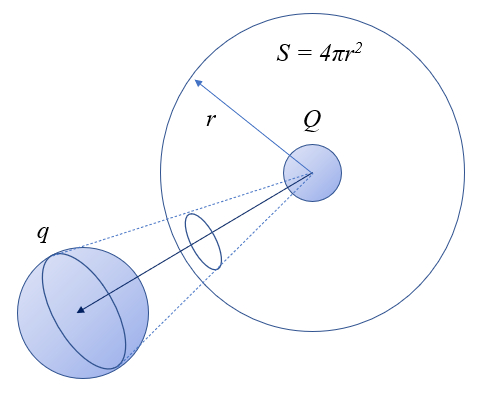Coulomb Law
Storyboard
The charges exert force between these being that if they are equal they are repulsive and if they are opposite it is attractive. The force is called Coulomb's law and is proportional to the product of the charges divided by the distance between them squared. The address is along the line that contacts both charges.
ID:(1497, 0)
Phenomenological description of the interaction between charges
Image
One way of understanding the shape of the force between two charges can be understood if we consider that the interaction is modeled as the exchange of particles that in this case are photons. The number of these messengers can be understood proportional to the load that emits them but also to the probability that they will be 'captured' by the other load. In that sense
would have to be proportional to the product of both loads.
On the other hand, these 'messengers' are emitted in all directions, distributed on an imaginary sphere around the load. Since this surface is equal to
would have to be inversely proportional to the surface of one sphere around the other charge, or inversely proportional to the square of the distance.
What is described can be represented graphically as the surface around one charge and the 'cone' in which the photons are captured by the other charge.

\\n\\nSo the force, as a scalar, would be of the form\\n\\n
$F\propto\displaystyle\frac{qQ}{4\pi r^2}$
ID:(11363, 0)
Coulomb Force
Image
Force between loads depend:
- the charges, being positive if both have the same sign and negative if they have opposite sign
- are reduced with the distance between squared loads
- acts in the direction defined by both charges

Apart from that, the forces overlap, that is to say that the total force acting on a load is equal to the sum of the forces caused by other charges without them interfering in any way.
ID:(1697, 0)
Versor of Coulomb's Law
Equation
The versor is a vector that reflects the direction and whose magnitude is unity. Therefore, for a distance vector
| $ \hat{r} =\displaystyle\frac{( \vec{s}_2 - \vec{s}_1 )}{| \vec{s}_2 - \vec{s}_1 |}$ |
ID:(10391, 0)
Coulomb's Law
Equation
If you have two loads
| $ r ^2=| \vec{s}_2 - \vec{s}_1 |^2$ |
in the direction defined by the versor, with position 1 $m$, position 2 $m$ and radius (vector) $m$
| $ \hat{r} =\displaystyle\frac{( \vec{s}_2 - \vec{s}_1 )}{| \vec{s}_2 - \vec{s}_1 |}$ |
the force between them is given by
| $ F =\displaystyle\frac{1}{4 \pi \epsilon_0 \epsilon }\displaystyle\frac{ q Q }{ r ^2}$ |
The field constant has a value of
ID:(3212, 0)
Coulomb's law for a charge distribution
Equation
Si se tiene una carga
| $ F =\displaystyle\frac{1}{4 \pi \epsilon_0 \epsilon }\displaystyle\frac{ q Q }{ r ^2}$ |
con charge $C$, constante de campo eléctrico $C^2/m^2N$, constante dieléctrica $-$, distance $m$, force (vector) $N$, pi $rad$ and test Charge $C$
en que las distancias se calculan con distance between charges $m$, position 1 $m$ and position 2 $m$ de
| $ r ^2=| \vec{s}_2 - \vec{s}_1 |^2$ |
y el versor con position 1 $m$, position 2 $m$ and radius (vector) $m$
| $ \hat{r} =\displaystyle\frac{( \vec{s}_2 - \vec{s}_1 )}{| \vec{s}_2 - \vec{s}_1 |}$ |
por lo que se obtiene con position 1 $m$, position 2 $m$ and radius (vector) $m$ la expresión
| $ \vec{F} =\displaystyle\frac{1}{4 \pi \epsilon_0 \epsilon }\sum_i^N\displaystyle\frac{ q Q_i }{| \vec{r} - \vec{u}_i |^3}( \vec{r} - \vec{u}_i )$ |
ID:(10392, 0)
0
Video
Video: Coulomb law
